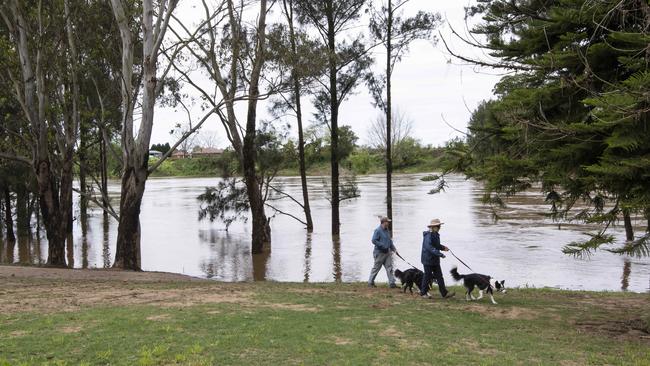NSW flood waters will continue to rise as rain eases
Over a weekend of wild winds and heavy rain, up to 120mm fell on heavily sodden ground as evacuation orders are issued.
Prolonged and widespread flooding of the western and southern areas of NSW continues as the state government today warned already rain-swollen rivers are yet to peak in many areas.
Over a weekend of wild winds and heavy rain, up to 120mm fell on heavily sodden ground in the Hunter, Illawarra and Central West regions, as mud brown waters poured into catchment areas and lapped around the walls of homes and businesses in Dubbo, Mudgee and Bathurst.
Other areas recorded 40-50mm of rain within 24 hours as fast rising waters and flash flooding isolated rural properties, cut off roadways and blocked landslips.
The NSW SES also fielded over a thousand emergency calls and made 44 flood rescues, including several motorists attempting to cross rapidly running rivers.
Emergency services have issued evacuation orders for low-lying areas along the Hawkesbury River and established evacuation centres in Richmond, North Richmond and Castle Hill.
There are 22 Bureau of Meteorology active flood warnings in a triangular area from the Riverina to the central west and to the north of Sydney.
Major flooding has been predicted for coming days for communities along the Lachlan, Macquarie, Namoi and Peel rivers and in the upper regions of the Murrumbidgee.
Meanwhile, NSW Agriculture Minister Dugald Saunders said fodder drops had been needed to feed stranded livestock and that vast surges of water running through paddocks will devastate some crops.
“The deluge of rain turned what are normally just little creeks of less than a metre into rampaging rivers of 30 and 40 metres wide through paddocks,” he told media.
“There’s a lot of crops that will be lost. Since the heavy rain began last week, we have already assisted three farmers in western NSW with emergency fodder drops because their livestock was stranded. We expect this number to increase in the coming days.”
The naturally rising waters have been artificially inflated by releases from Wyangala Dam into the Lachlan River and Burrunjuck Dam into the Murrumbidgee.
The Windamere Dam near Mudgee is spilling for the first time since 1990 and only second time in its history.

The BOM has predicted two days of relief for NSW before another round of wet weather is expected to lash the state from Wednesday to Friday. SES Commissioner Carlene York warned residents against complacency by entering floodwaters just because the rain had stopped.
“We’re seeing flash-flooding and serious riverine flooding rising,” she said.
“Just because it’s not raining, it doesn’t mean those rivers aren’t rising - water is still flowing into our catchment areas.”
In parts of NSW and Queensland, heavy rain prevented winter crops being planted on some arable land earlier this year and current rainfall has delayed the start of the winter harvest.
Meanwhile, storms are predicted for most of southern Queensland today, after parts of the central to southern interior, including the Condamine region, recorded up to 50mm of rainfall over the weekend.
So far this month western Queensland has received a drenching with 93mm falling in Charleville, 90mm in Thargomindah, 88mm in Cunnamulla, 62mm in Mitchell and 49mm in Longreach.
BOM senior meteorologist Steve Hadley said while the floods in NSW were currently more acute, Queensland was on a slow-burning path.
“The west of the state is flat and it takes longer for the water to move through the creeks and rivers and the flooding will evolve over a number of weeks,” he said.
“But Queensland is at a higher risk than normal of flooding this Spring and Summer, with more rain expected to fall in the south-west catchments and the ground already so wet and rivers responding to rainfall.”
There are currently minor flood warnings placed on the Bokhara, Balonne, Barcoo rivers and Cooper Creek in southern Queensland. While there are moderate warnings on the Bulloo and Paroo rivers and major flood warnings issues for the Lower Macintyre.
The unseasonal wet conditions have been far-reaching, with many flood-impacted communities in eastern Australia dealing with loss of life, livestock and income and large-scale property and environmental damage.
The top five wettest centres nationally so far this year are in NSW.
Last week, Sydney recorded its tenth day of 50mm this year and surpassed its 72-year annual record of 2194mm.
Communities in eastern Australia can expect above average rainfall for the remainder of the year after a third consecutive La Nina event was confirmed recently by the BOM.



